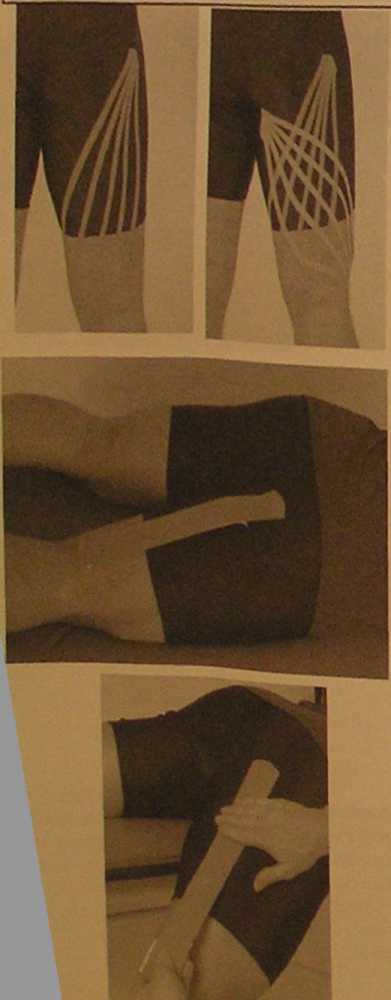P5140079
Hamstring Strain
A strain to the hamstring musclegroup (semimembranosus, semitendinous, or biceps femoris) is one of the most eommon muscle strains which results from physical activity. This muscle group may be overpowered by the larger quadricep$ muscle group, be injured due to lack of flexibility or over contrac. tion. Many hamstring strains can become chronic in naturę.
Begin by applying the Basic Kinesio Taping Technique for the hamstring strain. During the evaluation of the injur)' the practitioner will need to determine which of the hamstring is involved. It has been found to be helpful to apply a space or mechanical correction strip directly over the area of injury.
For acute muscle strains use the Kinesio I strip directly over the area of injury during the first 24-72 hours. Following this period use the Kinesio V strip, with the tails of the Y, surrounding the injured area

Ml
Application of lymphatic corrective technique to reduce hematoma resulting from bleeding. For review see lymphatic correction technique.
Two strips will be used.The first lymphatic fan strip should start medial to the ischial tuberosity and cross over the lateral aspect of the posterior thigh or area of possible hematoma. The second lymphatic fan strip should start lateral to the ischial tuberosity and cross over the medial aspect of the thigh in the area of possible hematoma.
The fan should create a crisscross pattem over the posterior aspect of the thigh..
Basic Kinesio Taping Method application of a hamstring muscle using a Kinesio I strip. Kinesio strip is placed directly over the area of pain.
Begin by placing the base of the Kinesio I strip as dose to the origin, ischial tuberosity, of the hamstring group as possible with no tension.
If using the Kinesio Y strip technique, surround the area of injury with the tails of the Y.
Have the patient move into hip flexion to place the hamstring on a stretch. If the patients rangę of motion is limited due to injury, additional tension will need to be added to the Kinesio I strip.
Apply light, 15-25% of available, or paper off tension to the Kinesio I strip. As the Kinesio Tape crosses over the area of injury, increase the Kinesio I strip tension to moderate, 25-50% of available tension (this will provide additional space for edema re-moval), then reduce tension over remaining length of Kinesio strip.
Lay down the last 2-3 inches of the Kinesio I strip with no tension. Intitiate glue activation prior to an further patient movement.
Application of mechaniki correction strip The mechanical correction I strip is placcd directly over the injured area. This providcs additional proprio-ceptive stimuli to the muscle for support, similar to wearing a neoprene sleeve. For complete review sec mechanical correction technique.
Begin by tearing the Kinesio 1 strip in the middle of the paper backing, and peeling back the middle third of the paper backing. Apply the Kinesio I strip with moderate to severe, 50-75% of available tension and downward pressure, directly over the injury site with the center of the Kinesio strip.
Lay down the tails of the Kinesio I strip with no tension. Initiate glue activation prior to any further patient movement.
Application of space correction strip. The space correction I strip is placed directly over the injured area. This further assists the removal of edema or hematoma formation from the injured muscle. For complete review see space correction technique.
Begin by tearing the Kinesio I strip in the middle of the paper backing, and peeling back the middle third of the paper backing. Apply the Kinesio I strip with light to moderate, 25-50% of available tension, directly over the injury site with the center of the Kinesio strip.
Lay down the tails of the Kinesio I strip with no tension. Initiate glue activation prior to any further patient movement.
Completed application of Basic Kinesio Taping Method for a hamstring muscle using the Kinesio I strip with space or mechanical correction strip.
113
Wyszukiwarka
Podobne podstrony:
P5140029 ScApulohumml DWunction wm oi Ihr * m Mattornhip to the humcrws during novm.il r»ngt* ot mot
an Insufficient blood flow to the heart muscle from narrowing of coronary artery may cause ches
f13 8 NCSA Mosaic ™ for Microsoft Windows Welcome to the Mosaic for Microsoft Windows Home Page. Mos
image002 ORBIT 4 The latest in a unigue. up to-the minute series of SF arC thologies. ORBIT 4 is “A
File0052 1 ii 2.03 Listen to the dialogue and choose will or going to. Debra Where’s the map? Rick t
085 (8) ler Herc is an alternatine to the cul-and-sewflowers on page 66. Thisflower is madę i„ crocl
•vx Editors Introduction to the Series othcrs, whether małe or female. It was an astonishing assert
While Lynton and Rajan are not referring to the hijras’ obscene language per se, their description i
DSC07923 292 M.B. Aberlin (1996) to be due to the fact that it contains iron oxide, which is a ferti
New?ventures Elementary Teacher s Book testy Unit 9 Test str 3 E Listening 13 Listen to the dialogu
FIELD INSTRUMENTS IN MEASUREMENT SYSTEMS Level transmitters can be xnnected to the MultiCONT prxess
•vx Editors Introduction to the Series othcrs, whether małe or female. It was an astonishing assert
CSG060 Unit 5The Imperfect TenseFormation of the Imperfect The imperfect (el preterito imperfecto or
więcej podobnych podstron